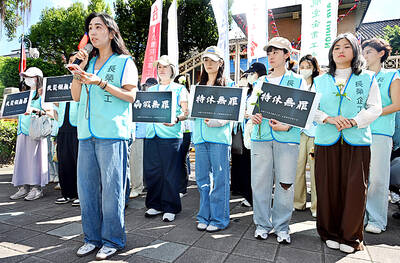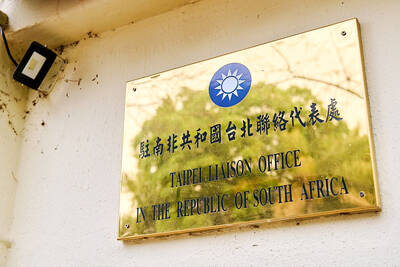A new report by a professor at the US Naval War College says Chinese military planners “covet the ability” to prevent US and allied forces from intervening effectively in the event of a Taiwan Strait crisis.
“The PLA [People’s Liberation Army] is improving rapidly in many areas, and has manifold advantages on which to draw, particularly in its proximity to, and focus on, the most likely scenario — a multi-vector PLA offensive to pressure Taiwan into reunification,” the report says.
Written by Andrew Erickson and just published by the Jamestown Foundation, the report says China is on the verge of achieving major breakthroughs with anti-ship ballistic missiles; streaming cruise missile attacks; precise and reliable satellites and space weapons.
The report claims such achievements could “radically improve” China’s anti-access and area denial capabilities by allowing it to dangerously threaten any ships or aircraft that enter “strategically vital zones” around the country.
Of greatest concern to Washington, the report says, is a solid propellant anti-ship ballistic missile (ASBM) with two stages and a reentry vehicle.
The sensors on this weapon may be able to find, and the warhead severely damage, an aircraft carrier.
With a range of about 1,500km, this missile could stop US aircraft carrier battle groups from entering an area “far beyond Taiwan and the First Island Chain into the Western Pacific.”
Erickson’s report says China may already be producing rocket motors for the missile in a purpose-built factory.
If developed and deployed successfully, the anti-ship ballistic missile “would be the world’s first weapons system capable of targeting a moving carrier strike group hundreds of kilometers from China’s shores from long-range, land-based mobile launchers,” the report says.
While there have been previously published reports of the missile, this stark warning from Erickson — a founding member of the China Maritime Studies Institute — is alarming.
The US Navy has developed systems to deal with anti-ship cruise missiles but this weapon is “qualitatively different.”
For one thing, a US attack on the launchers — hidden well inside China — would be “highly escalatory” and would risk all-out war.
However, the report quotes an unnamed US Department of Defense official as saying that Beijing scientists “still have a ways to go” before they can integrate the missile system with its command and control computers and with intelligence, surveillance and reconnaissance systems.
“Yet China has many ways to mitigate limitations for kinetic operations around Taiwan,” the report says.
“While conflict is by no means foreordained and interaction and cooperation should be pursued whenever feasible and equitable, the challenge presented by China’s emerging anti-access and area-denial infrastructure cannot be ignored,” it says.
“Long before a crisis, and to deter one from ever erupting, US leaders need to ask, ‘where are threats to our carriers and how can we counter them?’” the report says.
In related developments, former National Airborne Corps (NAC) director Chen Chung-hsien (陳崇賢) told reporters on Monday that the 60 UH-60M Black Hawk helicopters the US agreed to sell to Taiwan as part of a major arms package earlier this year would be delivered in 2013. The military said it planned to allot 15 to the NAC for civil rescue operations.
The NAC said the 15 helicopters would substantially improve the nation’s air rescue capabilities.
The NAC said the Army was also in negotiations with Bell Helicopter on an upgrade program for NAC’s UH-1H helicopters.
ADDITIONAL REPORTING BY RICH CHANG

A drunk woman was sexually assaulted inside a crowded concourse of Taipei Railway Station on Thursday last week before a foreign tourist notified police, leading to calls for better education on bystander intervention and review of security infrastructure. The man, surnamed Chiu (邱), was taken into custody on charges of sexual assault, taking advantage of the woman’s condition and public indecency. Police discovered that Chiu was a fugitive with prior convictions for vehicle theft. He has been taken into custody and is to complete his unserved six-month sentence, police said. On Thursday last week, Chiu was seen wearing a white

The Taoyuan Flight Attendants’ Union yesterday vowed to protest at the EVA Air Marathon on Sunday next week should EVA Airway Corp’s management continue to ignore the union’s petition to change rules on employees’ leave of absence system, after a flight attendant reportedly died after working on a long-haul flight while ill. The case has generated public discussion over whether taking personal or sick leave should affect a worker’s performance review. Several union members yesterday protested at the Legislative Yuan, holding white flowers and placards, while shouting: “Life is priceless; requesting leave is not a crime.” “The union is scheduled to meet with

‘UNITED FRONT’ RHETORIC: China’s TAO also plans to hold weekly, instead of biweekly, news conferences because it wants to control the cross-strait discourse, an expert said China’s plan to expand its single-entry visa-on-arrival service to Taiwanese would be of limited interest to Taiwanese and is a feeble attempt by Chinese administrators to demonstrate that they are doing something, the Mainland Affairs Council said yesterday. China’s Taiwan Affairs Office (TAO) spokesman Chen Binhua (陳斌華) said the program aims to facilitate travel to China for Taiwanese compatriots, regardless of whether they are arriving via direct flights or are entering mainland China through Hong Kong, Macau or other countries, and they would be able to apply for a single-entry visa-on-arrival at all eligible entry points in China. The policy aims

COUNTERMEASURE: Taiwan was to implement controls for 47 tech products bound for South Africa after the latter downgraded and renamed Taipei’s ‘de facto’ offices The Ministry of Foreign Affairs is still reviewing a new agreement proposed by the South African government last month to regulate the status of reciprocal representative offices, Minister of Foreign Affairs Lin Chia-lung (林佳龍) said yesterday. Asked about the latest developments in a year-long controversy over Taiwan’s de facto representative office in South Africa, Lin during a legislative session said that the ministry was consulting with legal experts on the proposed new agreement. While the new proposal offers Taiwan greater flexibility, the ministry does not find it acceptable, Lin said without elaborating. The ministry is still open to resuming retaliatory measures against South